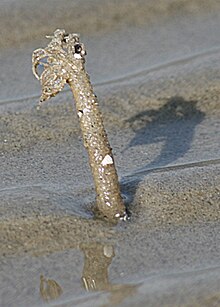Lanice conchilega
| Lanice conchilega | |
|---|---|
 |
|
| Tube projecting from the sediment | |
| Scientific classification | |
| Kingdom: | Animalia |
| Phylum: | Annelida |
| Class: | Polychaeta |
| Order: | Terebellida |
| Family: | Terebellidae |
| Subfamily: | Terebellinae |
| Genus: | Lanice |
| Species: | L. conchilega |
| Binomial name | |
|
Lanice conchilega Pallas, 1766 |
|
| Synonyms | |
|
|
Lanice conchilega, commonly known as the sand mason worm, is a species of burrowing marine polychaete worm. It builds a characteristic tube which projects from the seabed, consisting of cemented sand grains and shell fragments with a fringe at the top.
Polychaetes, or marine bristle worms, have elongated bodies divided into many segments. Each segment may bear setae (bristles) and parapodia (paddle-like appendages). Some species live freely, either swimming, crawling or burrowing, and these are known as "errant". Others live permanently in tubes, either calcareous or parchment-like, and these are known as "sedentary".
L. conchilega can grow up to thirty centimetres long with as many as three hundred segments. It has an elongated body divided into two parts. The head bears a dense tuft of long, thin tentacles. The upper lip is narrow and encloses the mouth. The buccal segment has protruding lobes laterally and ventrally and there are many eye spots. Segments 2 to 4 bear branching gills with broad stems and a thick crown. The third segment has a large lobe that obscures the second segment. Posterior to these, the thoracic region consists of seventeen segments and is cylindrical and firm. There are glandular pads on the ventral sides of segments 14 to 20 which bear both hair-like and hooked chaetae. The long, slender abdomen is soft and bears only hooked chaetae. The worm is yellowish, pink or brown with pale-coloured tentacles and red gills.
L. conchilega is found in the northern hemisphere in many parts of the world. It is found living in soft sediments, sand or muddy sand and among Zostera and benthic algae. It is tolerant of low salinity and is found in the eulittoral zone and at depths down to 1700 metres.
L. conchilega lives in a straight tube composed of large sand grains and shell fragments cemented with mucus that protrudes several centimetres from the surface of the sediment. The long tentacles protrude from the top searching for food particles and are supported by the fringe-like rim of the tube. The worm can retreat rapidly into the tube if danger threatens, and can extend the tube if it becomes buried in shifting sediment.
...
Wikipedia
